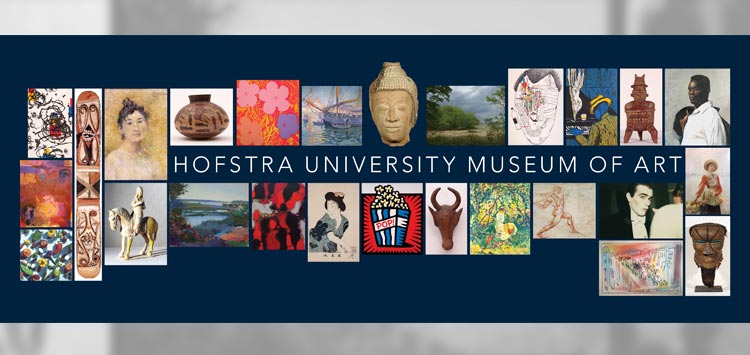Bearden, Lawrence, Parks: Artists of Influence
January 29 - April 5, 2007
David Filderman Gallery, 9th floor, Axinn Library
Bearden, Lawrence and Parks: Artists of Influence, is an exhibition of prints and photographs drawn from the Hofstra University Museum's holdings. These three twentieth-century American artists have been acclaimed for their individual talents and for the way in which they communicated the African-American experience, in essence, turning it into the human experience.
Romare Bearden (1912-1988) was born to a middle-class family in North Carolina and raised in Pittsburgh and Harlem. He was a graduate of New York University, a student of famed artist George Grosz at the Art Student's League in New York City, and studied art and philosophy at the Sorbonne in Paris. He traveled widely through Europe and was influenced by many sources including: 13th century Italian panel painting, 17th century Dutch genre scenes, the African-inspired Cubism of Picasso, the jazz of the Harlem Renaissance era and Abstract Expressionism. Between the 1930s -1960s he worked as a social worker, creating his art in the evenings.
In 1963, Bearden co-founded the Spiral group (1963-1966), which brought together a group of black artists to consider how to respond to the increasing racial tensions of the period, and to determine what their place should be in the art world of that time. Bearden suggested a collaborative project to show their unity. He wanted to do a collage of black life from magazine photographs but no one was interested. It was at this pivotal time in Bearden's long career that he first conceived of the possibilities inherent in the medium.
He began his experimentations with painted rectangles of paper on the work surface and then superimposed bits of photographs and other pieces of paper and fabric until the abstract elements suggested subjects to him. He then added additional paint to the artwork.
Throughout the years, Bearden continued his exploration of the medium. A songwriter as well, Bearden used the rhythms and improvisations of blues and jazz in many of his creations. His works were universal in nature and depicted every day life in rural and urban America, industrialism, music, ancient myths and traditional stories. As an art historian Bearden researched and wrote books educating the public about African American artists.
Jacob Lawrence (1917-2000) was born in New Jersey, lived in Pennsylvania and in 1930 moved to Harlem as a young teen. At the age of 15 he took classes at the Harlem Art Workshop under Charles Alston and in 1937 obtained a scholarship to the American Artists School. By the age of 21 he was employed by the Works Progress Administration (WPA), created by President Franklin D. Roosevelt, working as a professional painter in the easel division.
His subject matter was established early on. In his paintings, and later in his prints, he turned to the history and culture of African Americans and for the universal quest for justice, equality and human dignity. He was a story teller who often utilized a series format. While still in his early 20s, at a time when black American history was unknown to most, Lawrence, in his art, chronicled the lives of Harriet Tubman and Frederick Douglass, freedom fighters of the Civil War era.
In 1941, he won accolades for his epic series The Migration of the Negro, consisting of 60 narrative panels, which depicted the mass movement of thousands of black Americans from the rural South to the industrial North that began after World War I. As a result of this series Lawrence, at the age of 24, became the first black artist to be exhibited in a major art gallery (Downtown Gallery in New York City.) The narrative works that he continued to create in his paintings and prints, were bold in color, texture, line and pattern with flat shapes in pure colors. He said that his pictures expressed his life and experiences, and man's search for the ideal society. Other series included This is Harlem (1940s), Hospital (1949), Struggle: From the History of the American People (1955-56) and Hiroshima (1982). Lawrence taught at numerous New York City universities and schools around the country.
Gordon Parks (1912-2001) was one of 15 children born to a poor farmer in Kansas. Homeless at the age of 16 he made up his mind that race would not determine his future life. He worked as a bus boy, a pianist and then as a waiter on the Northern Pacific Railroad., where he first saw photographic images in magazines taken by Farm Security Administration photographers Ben Shahn, Dorothea Lange and Walker Evans. In 1937 he purchased his first camera from a pawn shop and his first break came when he was hired by an exclusive women's store in St. Paul, Minnesota to do fashion photography. With the aid of the famed boxer Joe Louis' wife he moved to Chicago and photographed white society women. On his own time he documented the slums of the city and with a sufficient body of work won the Julius Rosenwald Fellowship, a grant for black artists; he was the first photographer recipient.
In 1942 with a $200 a month stipend he went to Washington, D.C. and apprenticed with Roy Stryker, the director of the Farm Security Administration photography unit. Some of Parks' best documentary photographs were taken at this time including his signature piece of a black cleaning woman, American Gothic.
Parks then worked for the Office of War Information and did free lance work for Glamour and Vogue magazines, the first black photographer to obtain such assignments. In 1948 Parks became the first black staff photographer for Life magazine. By 1970 he had completed over 300 assignments specializing in subjects relating to poverty, racism and black urban life as well as pictures of Paris fashions and celebrities, many with essays written by him. Parks was also a filmmaker, writer, composer and poet. He was the first black artist to produce and direct a major Hollywood film, The Learning Tree (1969), followed by the commercial hit Shaft in 1971. In his later photographic works from 1979-1981 he turned to color abstractions and flower studies.
These three men with paintbrush, lens and printmaking equipment have through their art, communicated the African-American experience and broke barriers in doing it. Acclaimed for their artistic talents with countless gallery exhibitions and museum retrospectives, the works of Bearden, Lawrence and Parks are in the collections of major museums, both here and abroad.
Eleanor Rait
Curator of Collections
Hofstra University Museum
Bearden, Lawrence, Parks: Artists of Influence
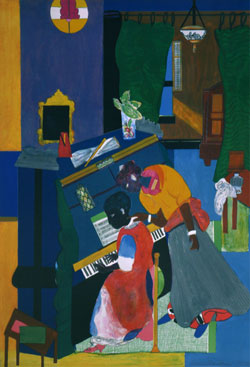
Romare Bearden
Homage to Mary Lou (The Piano Lesson), 1984
Lithograph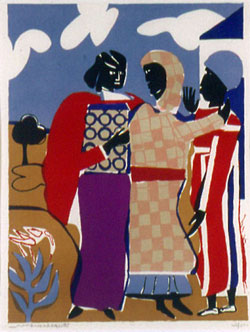
Romare Bearden
Three Women (Easter Sunday), 1979
Lithograph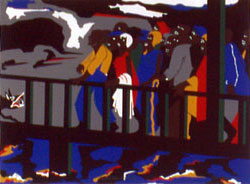
Jacob Lawrence
Confrontation at the Bridge, 1975
Screenprint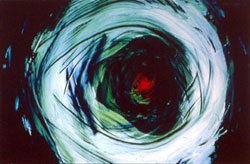
Gordon Parks
Labyrinth, 1981
Dye transfer print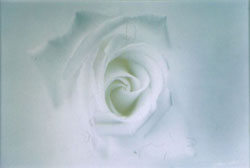
Gordon Parks
Rose (White), 1981
Dye transfer print
